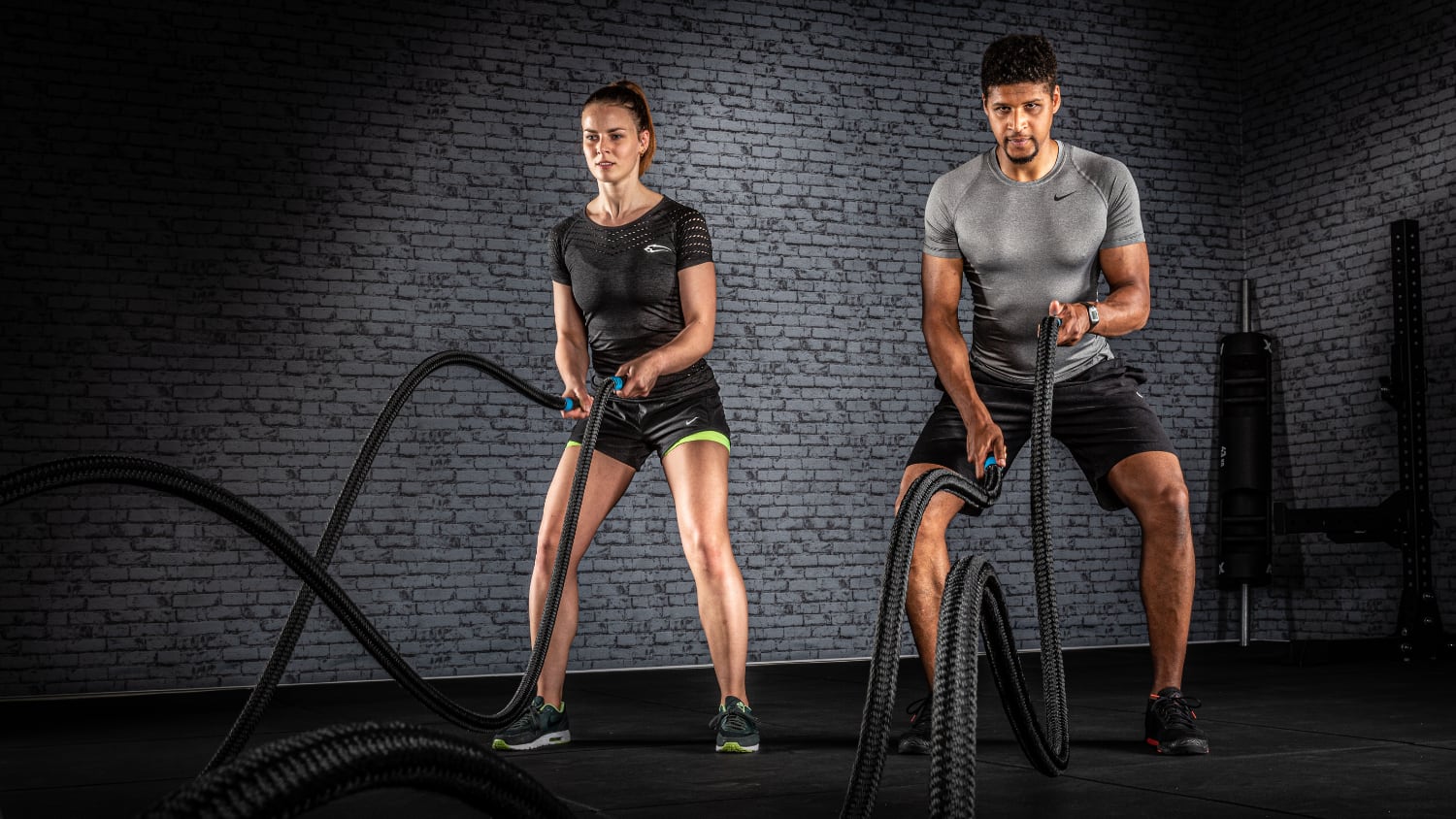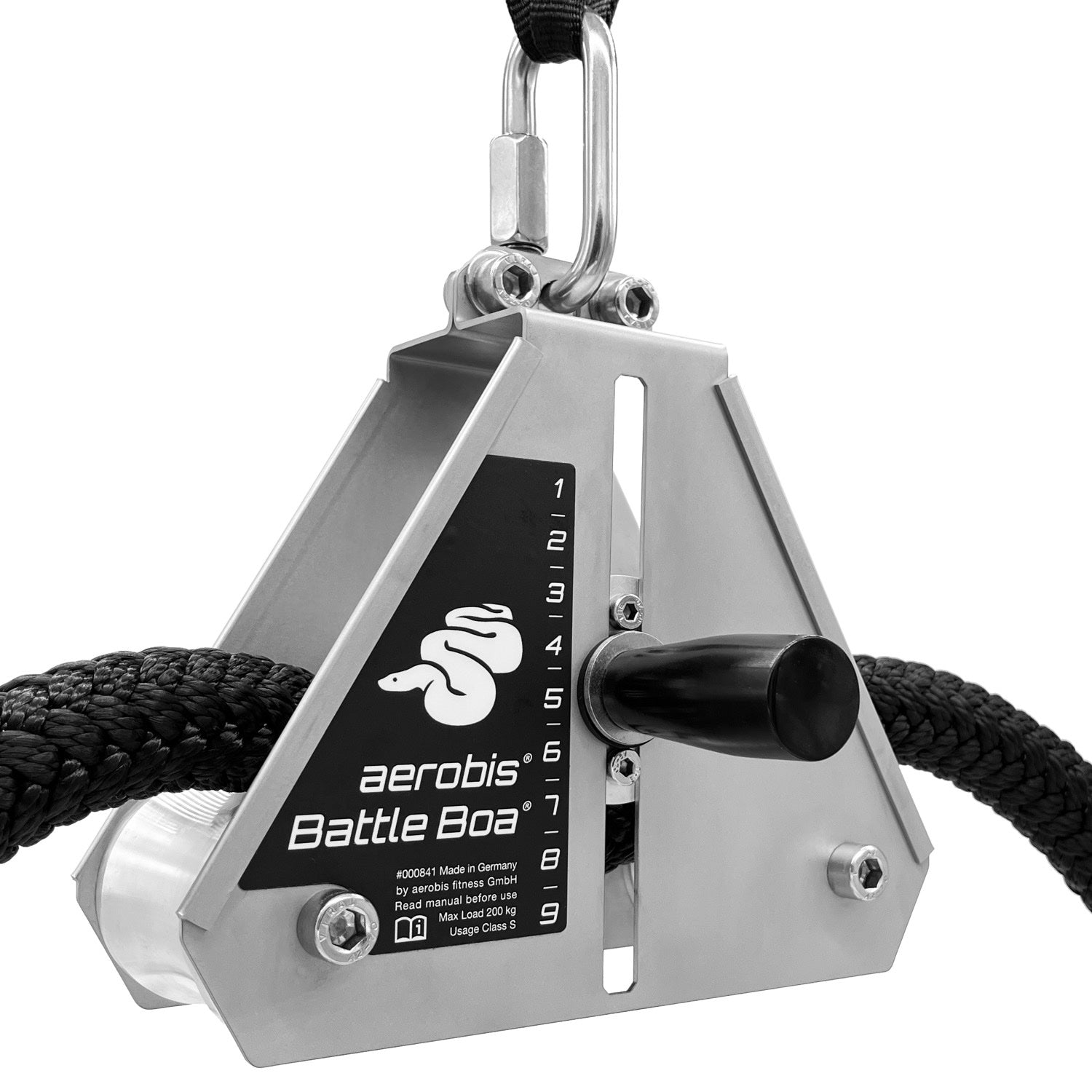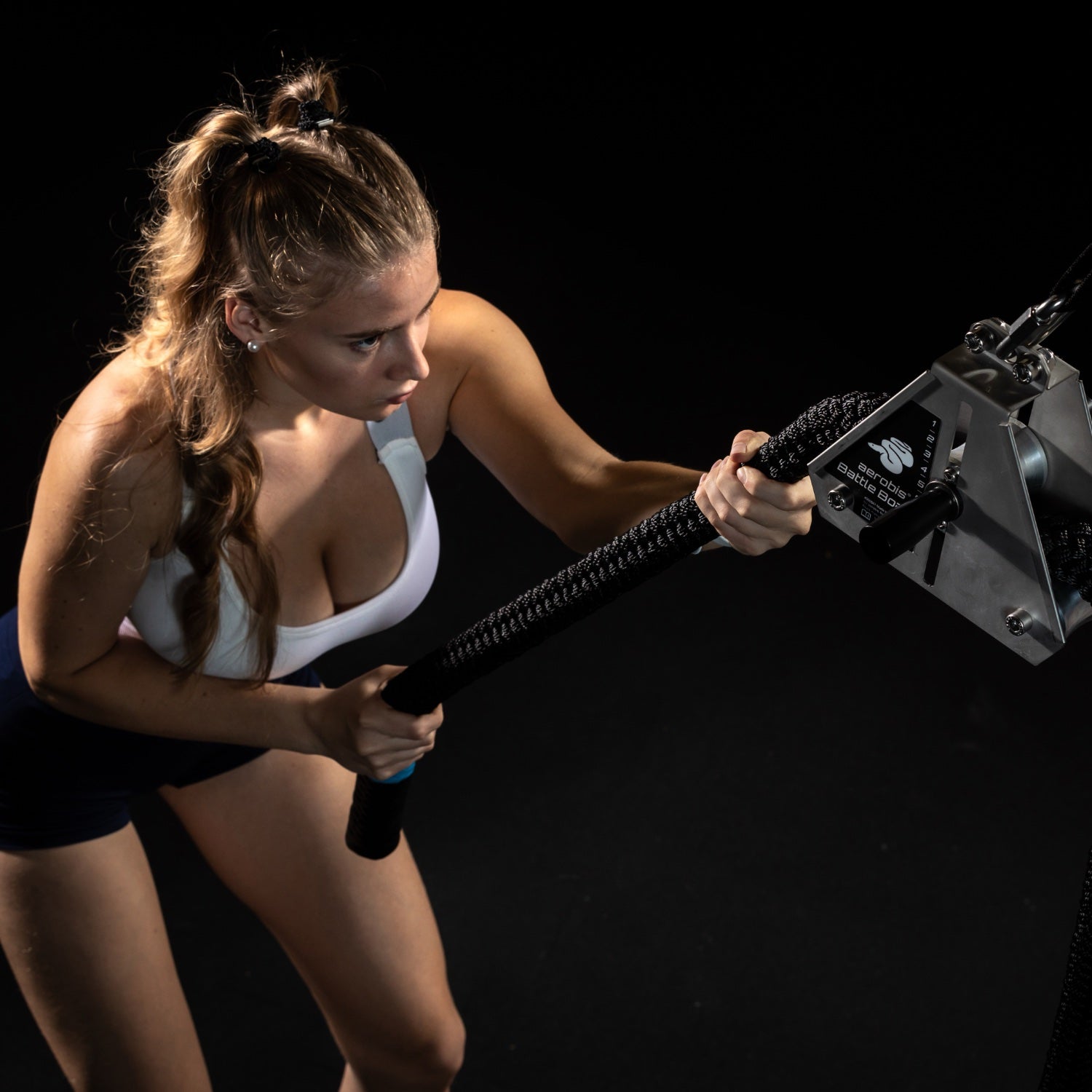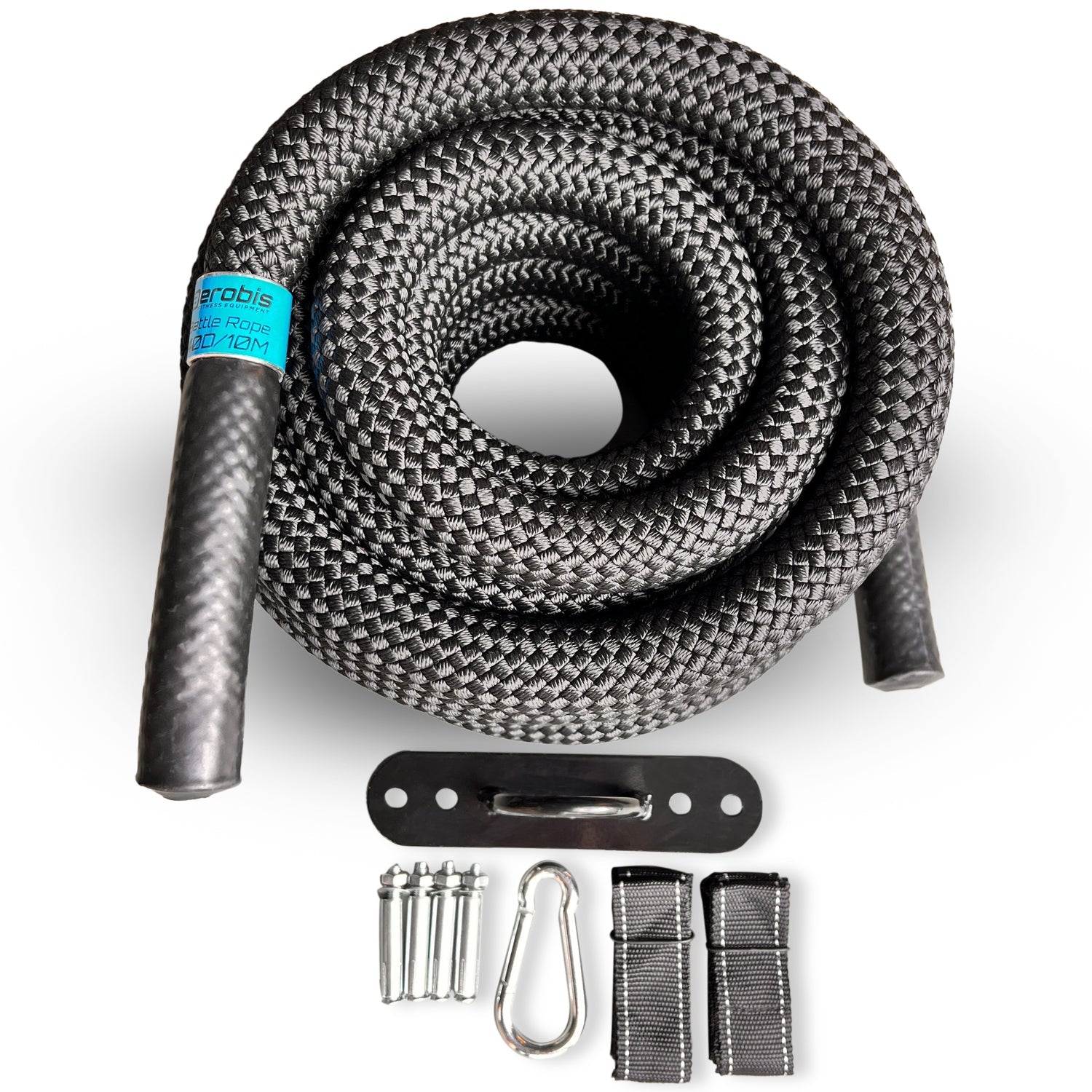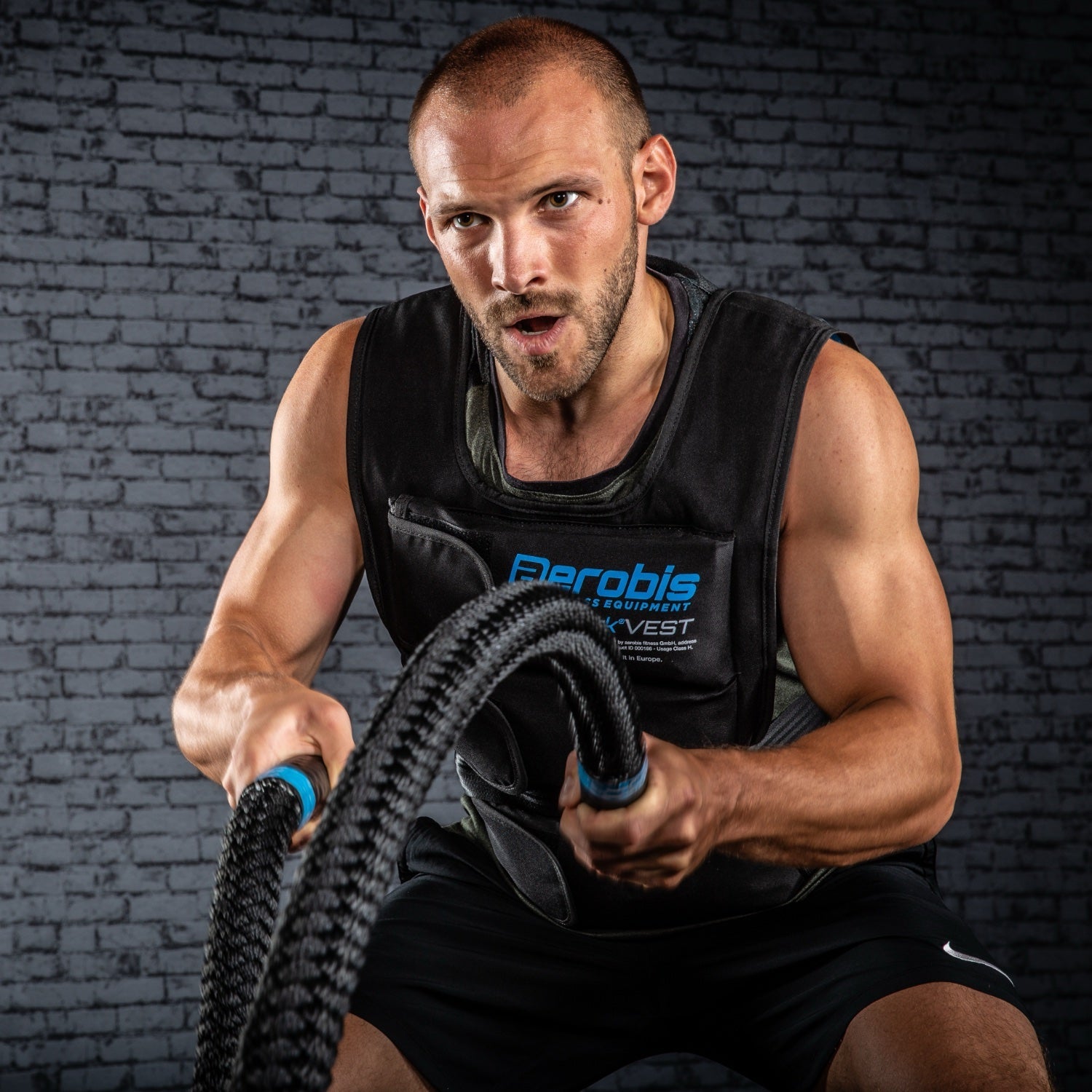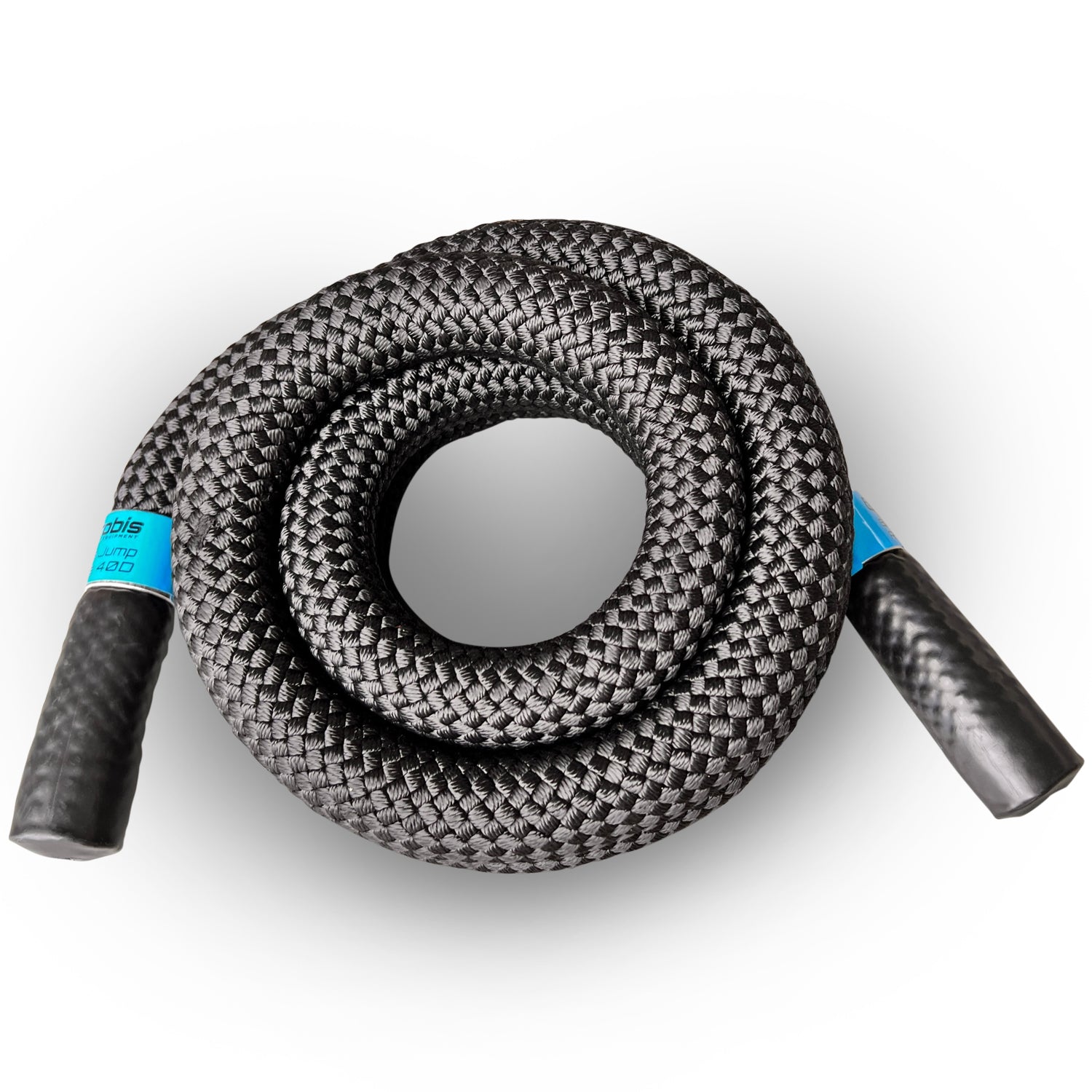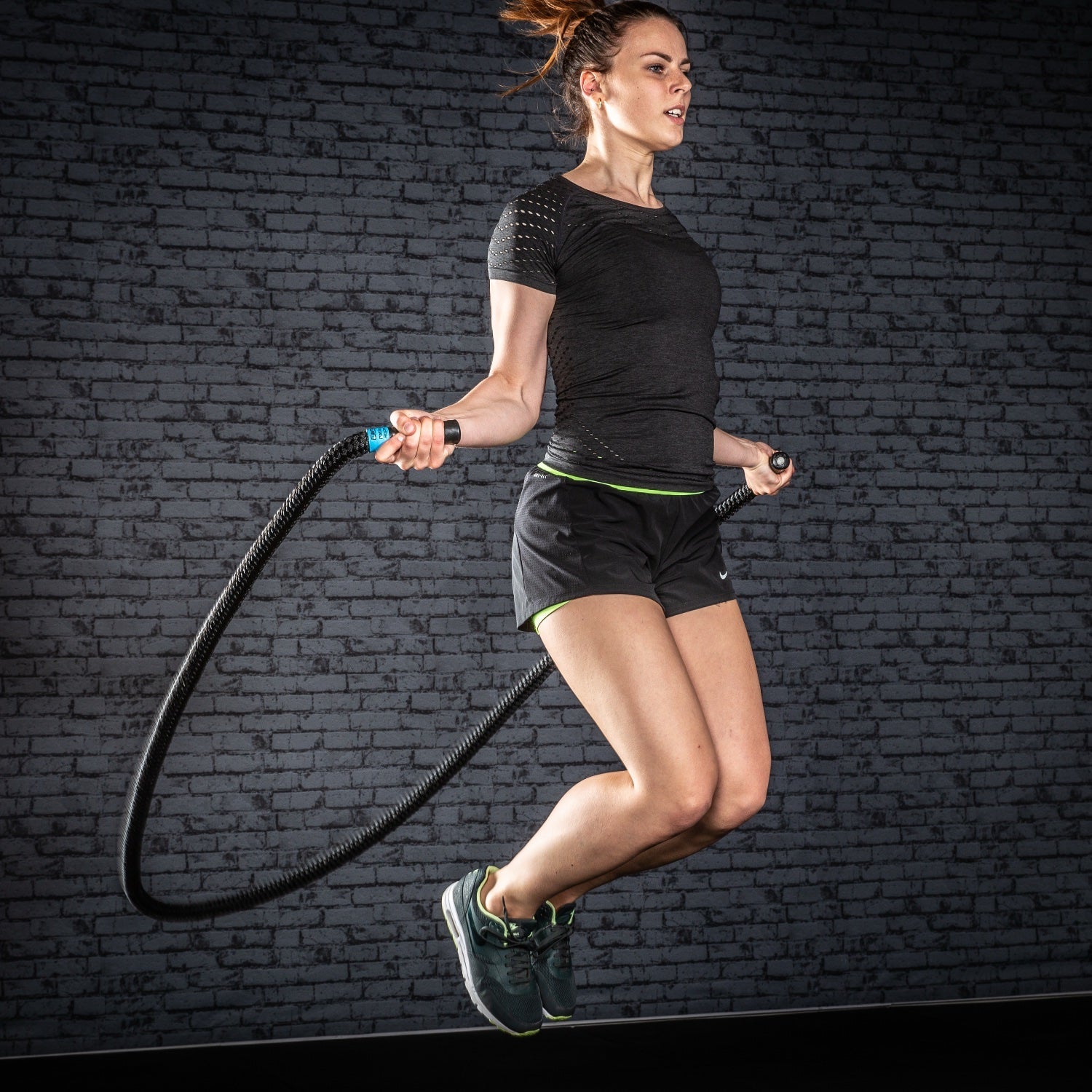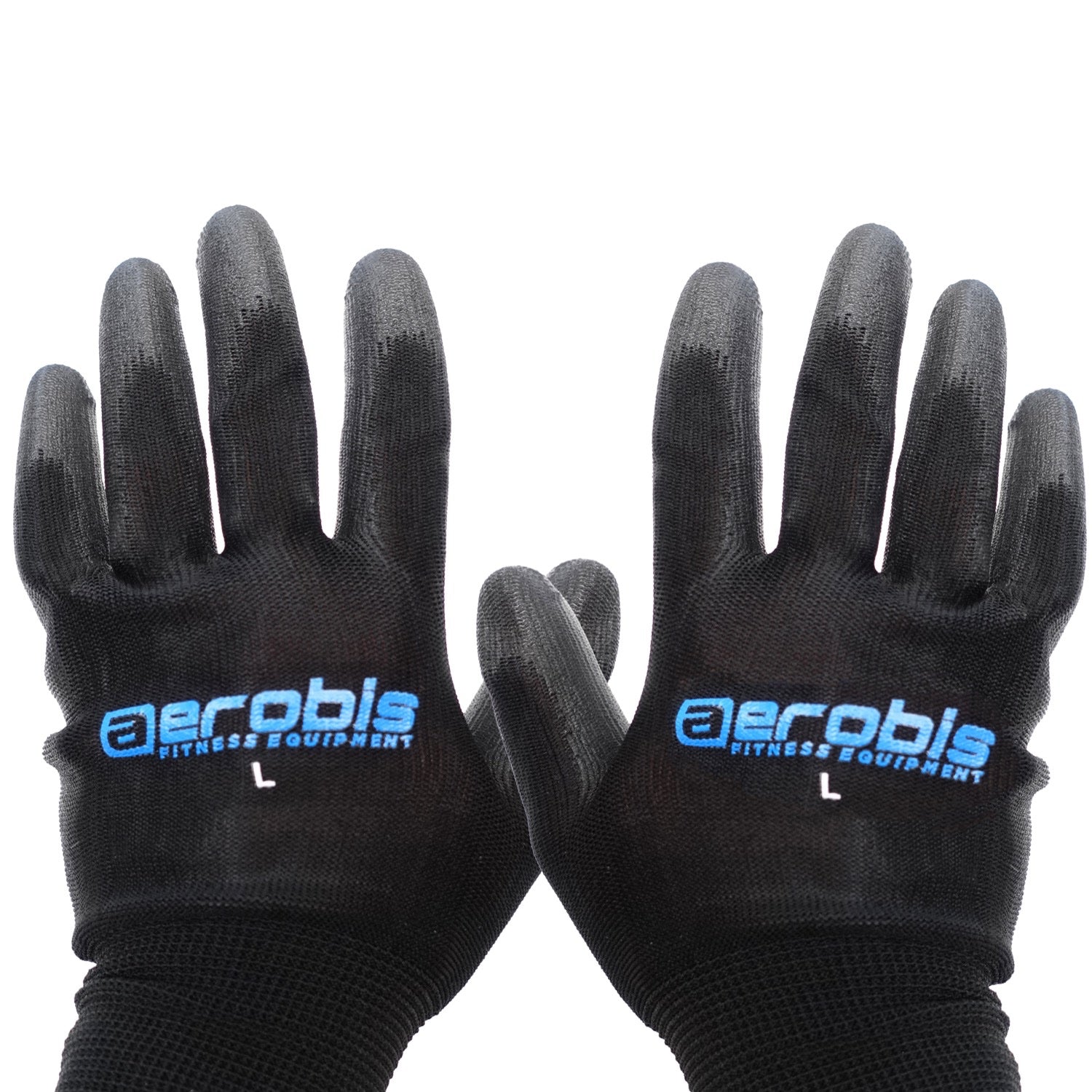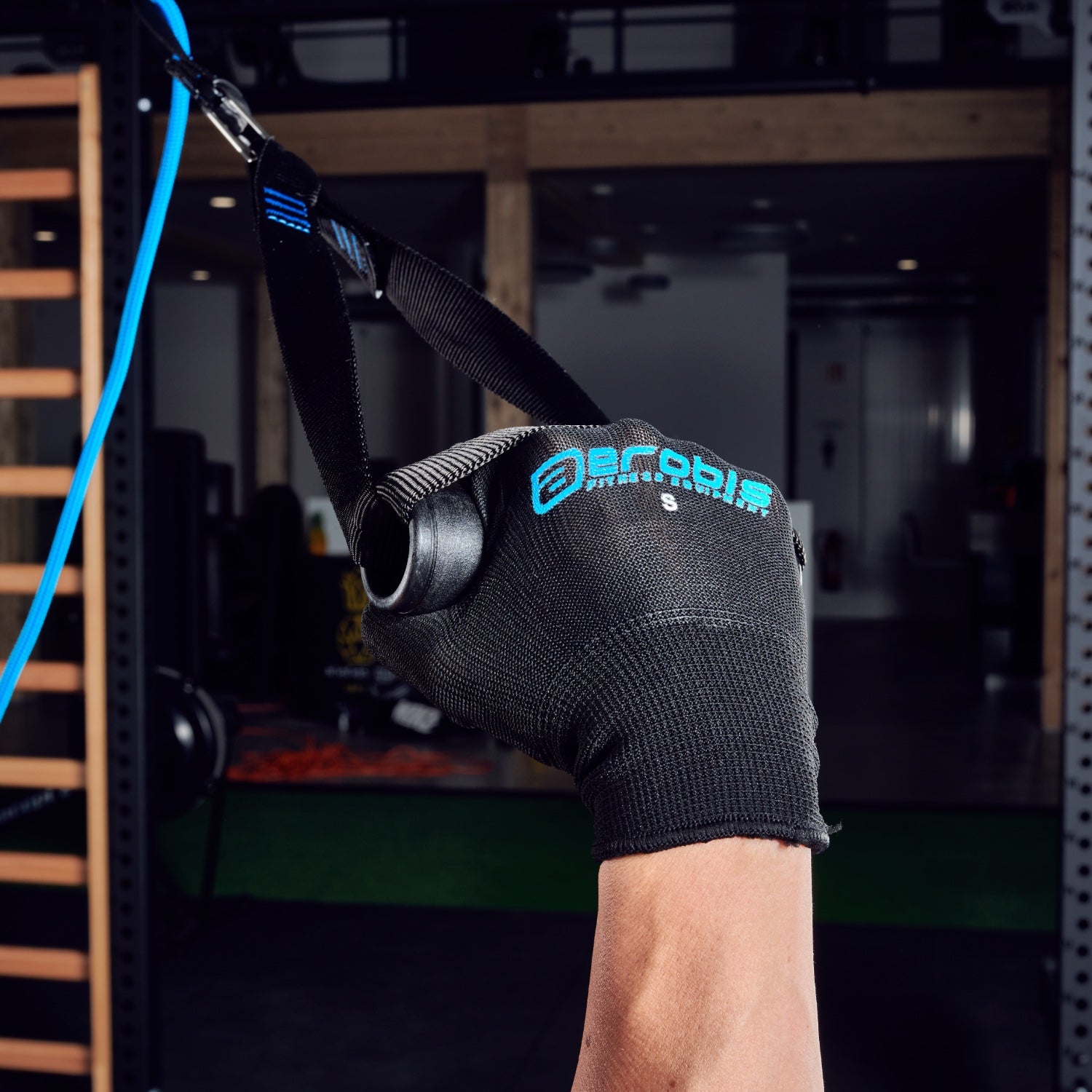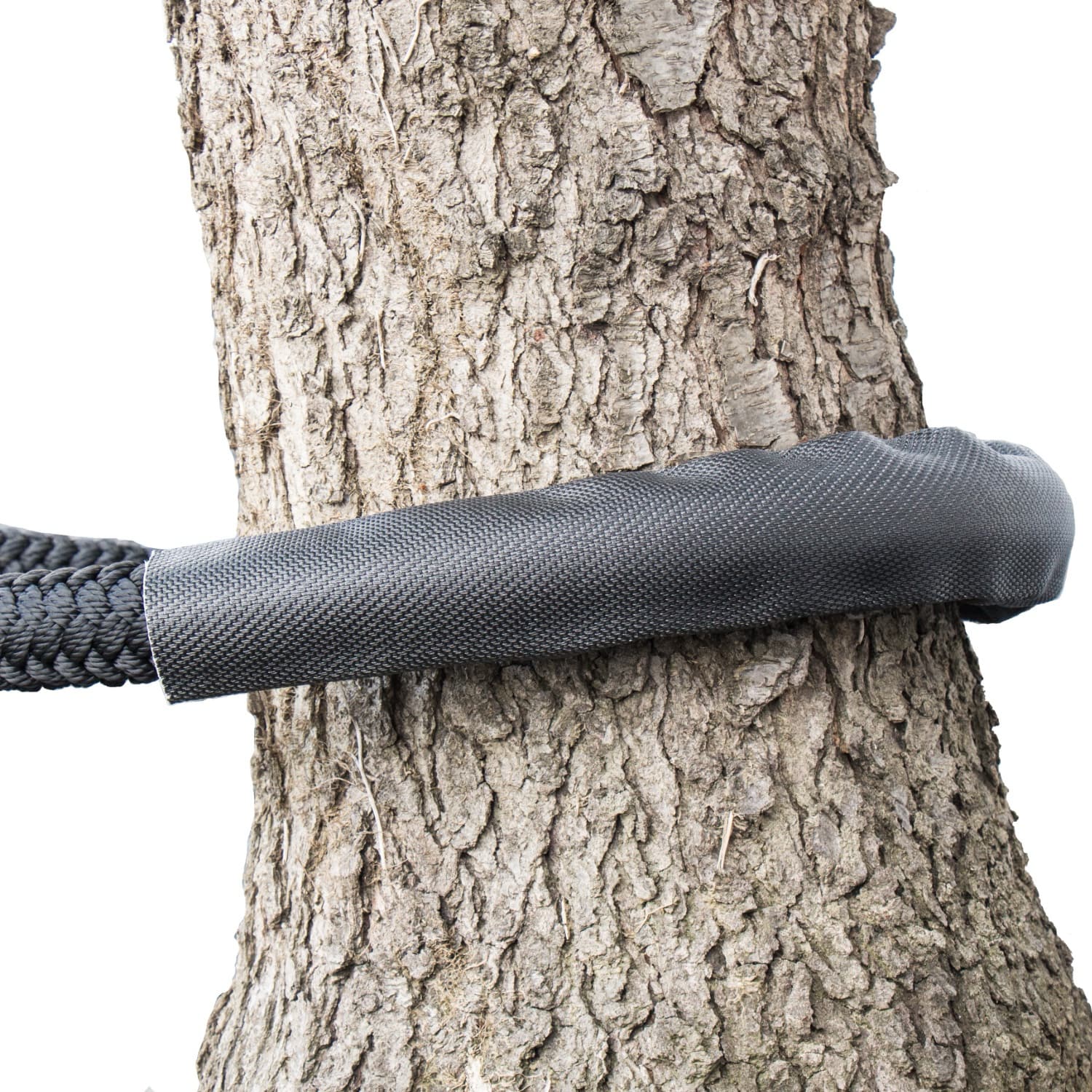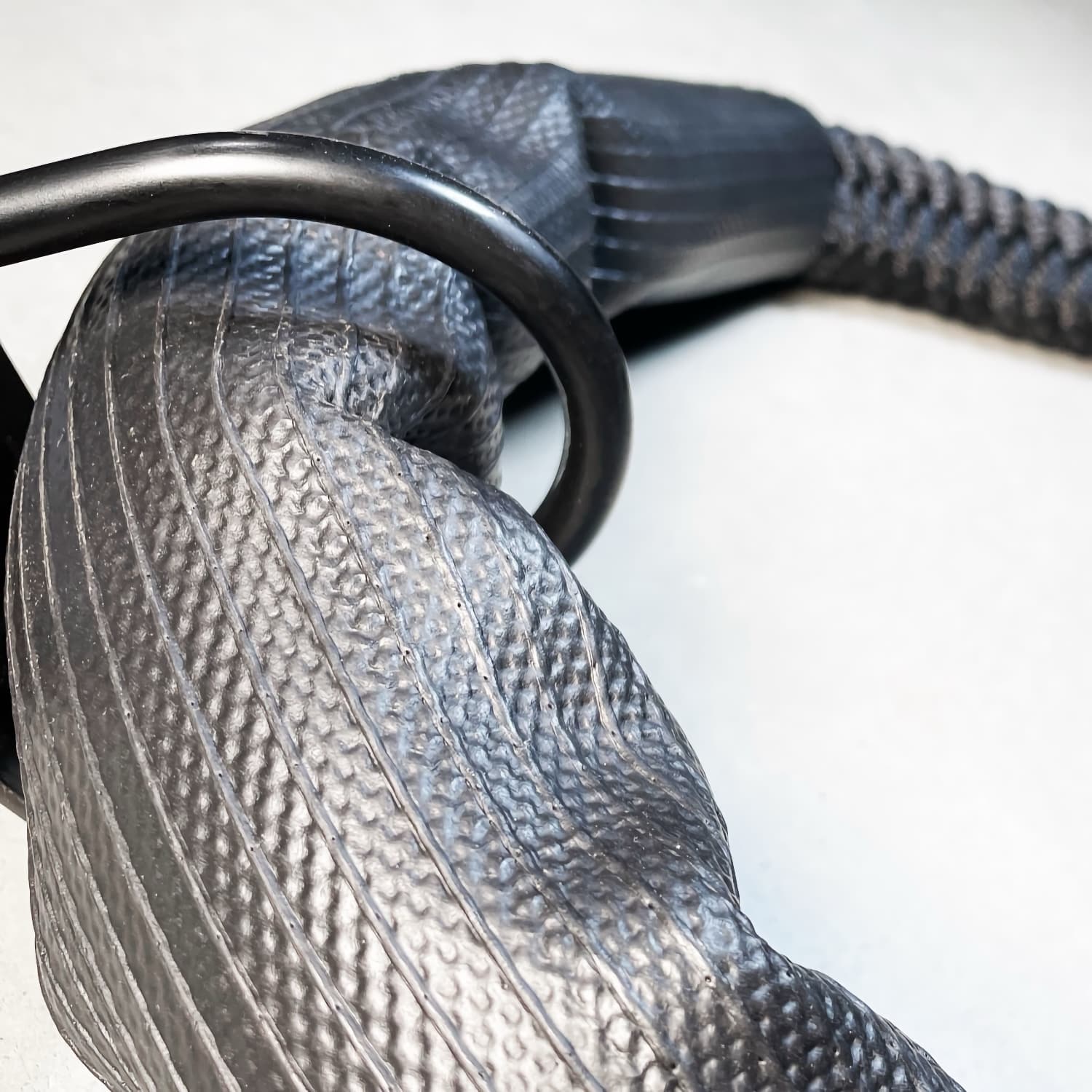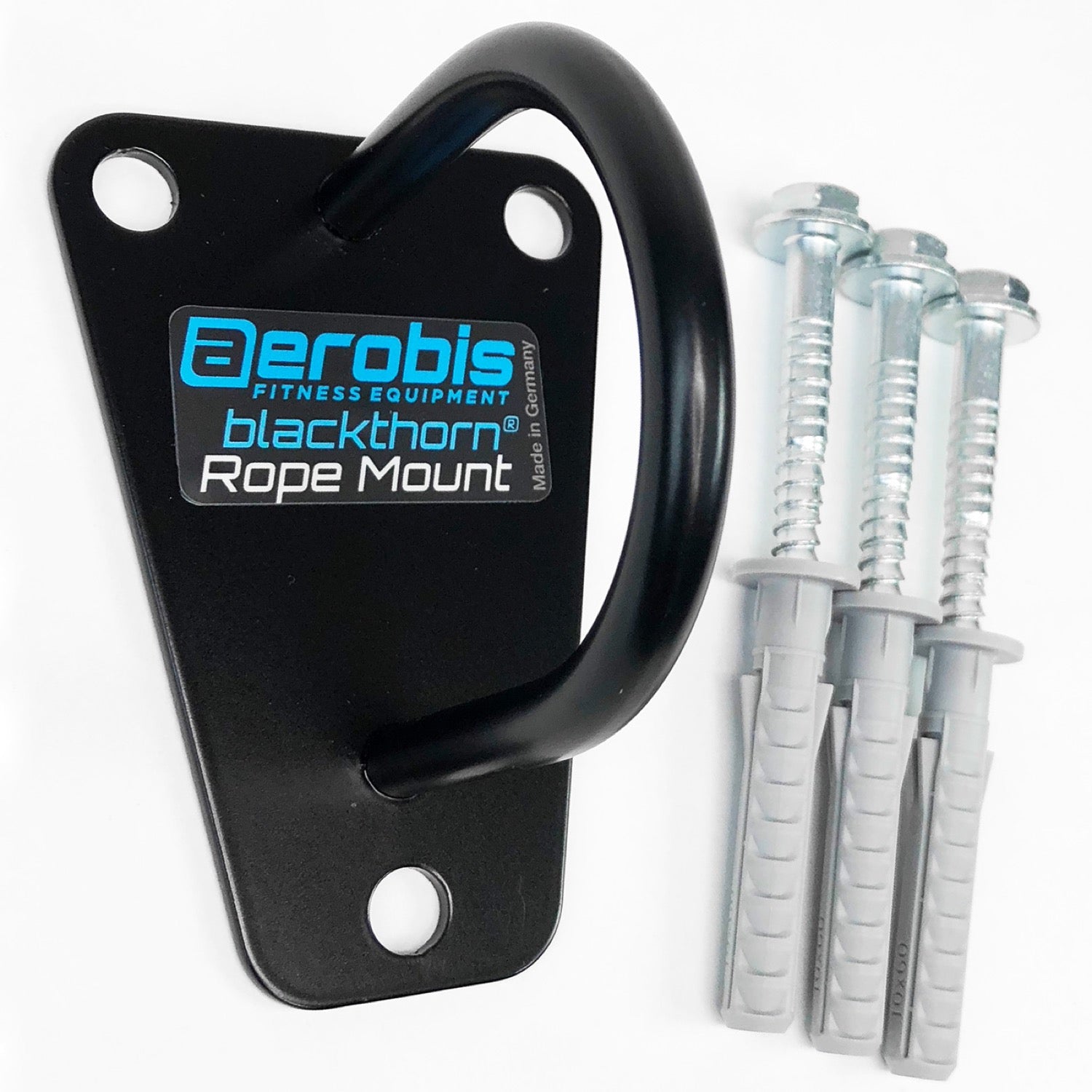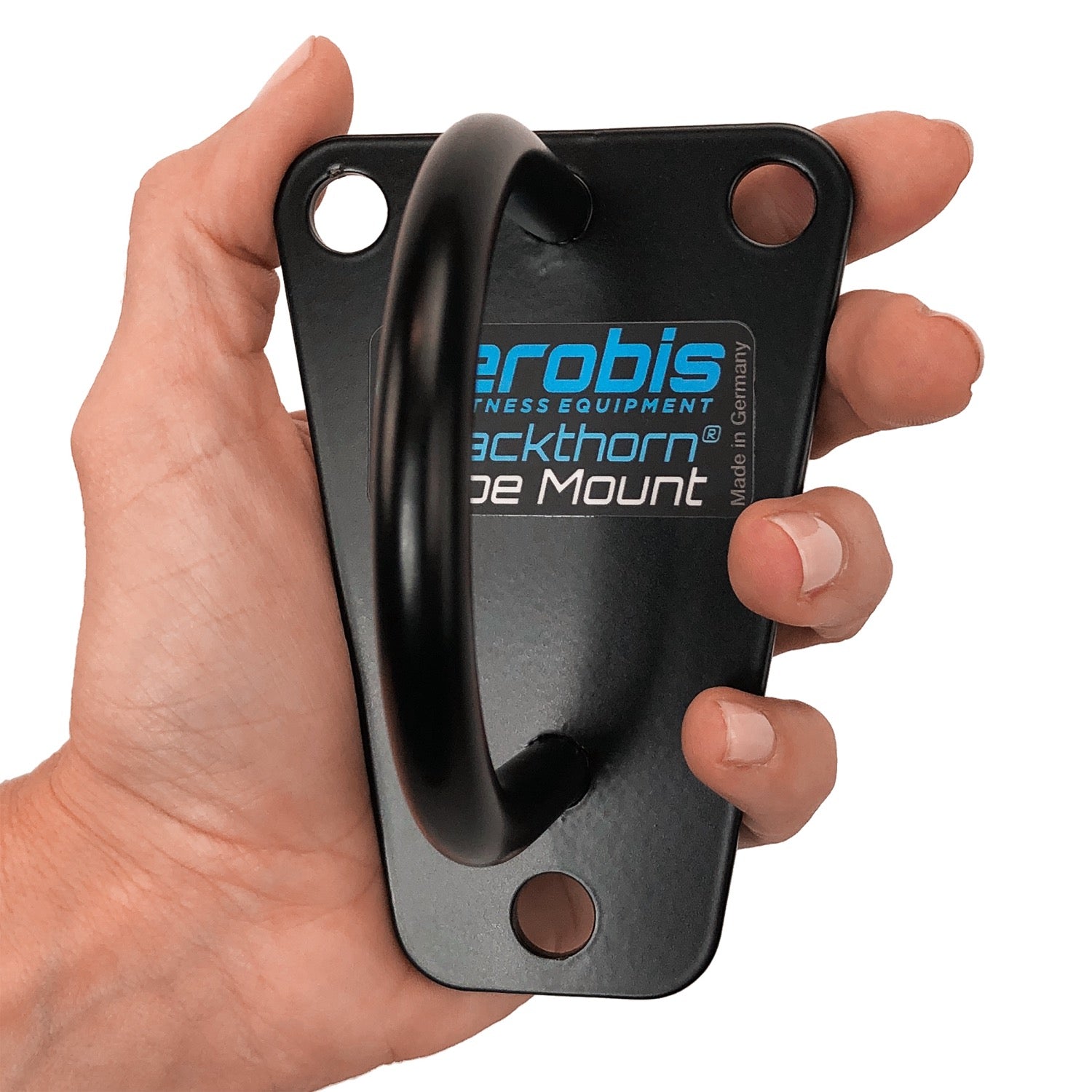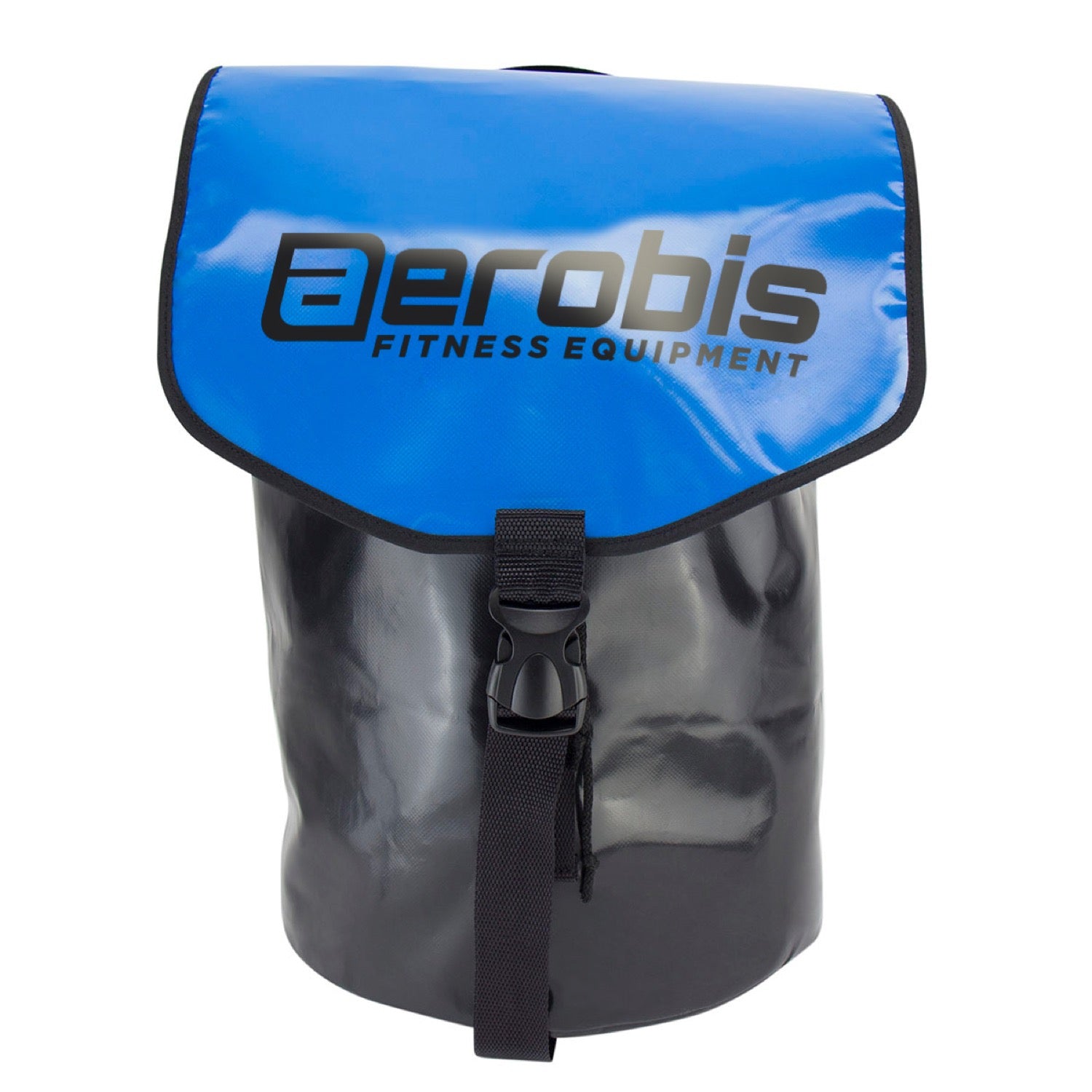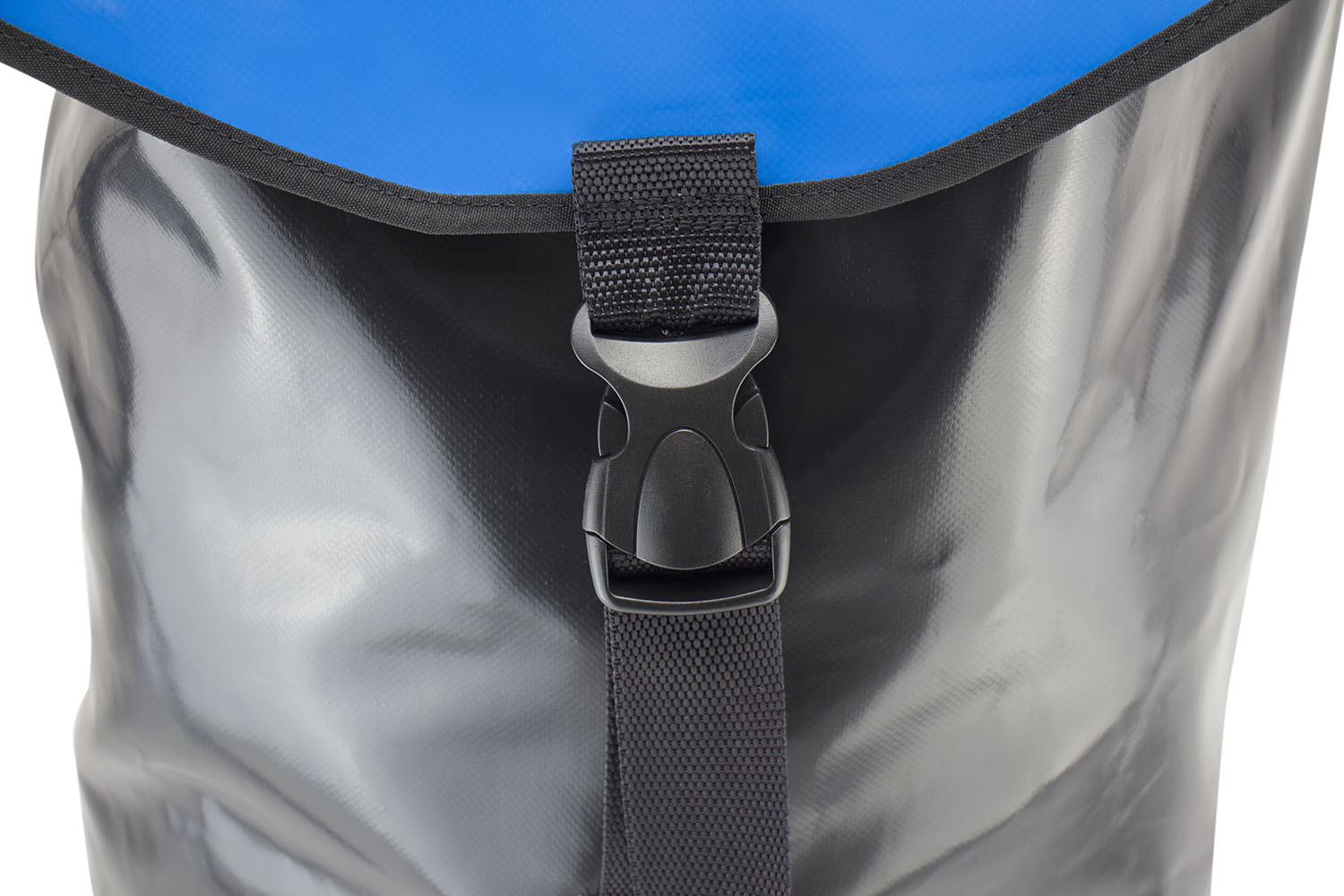Battle Rope Accessories
Battle Rope training – Extreme Endurance Training
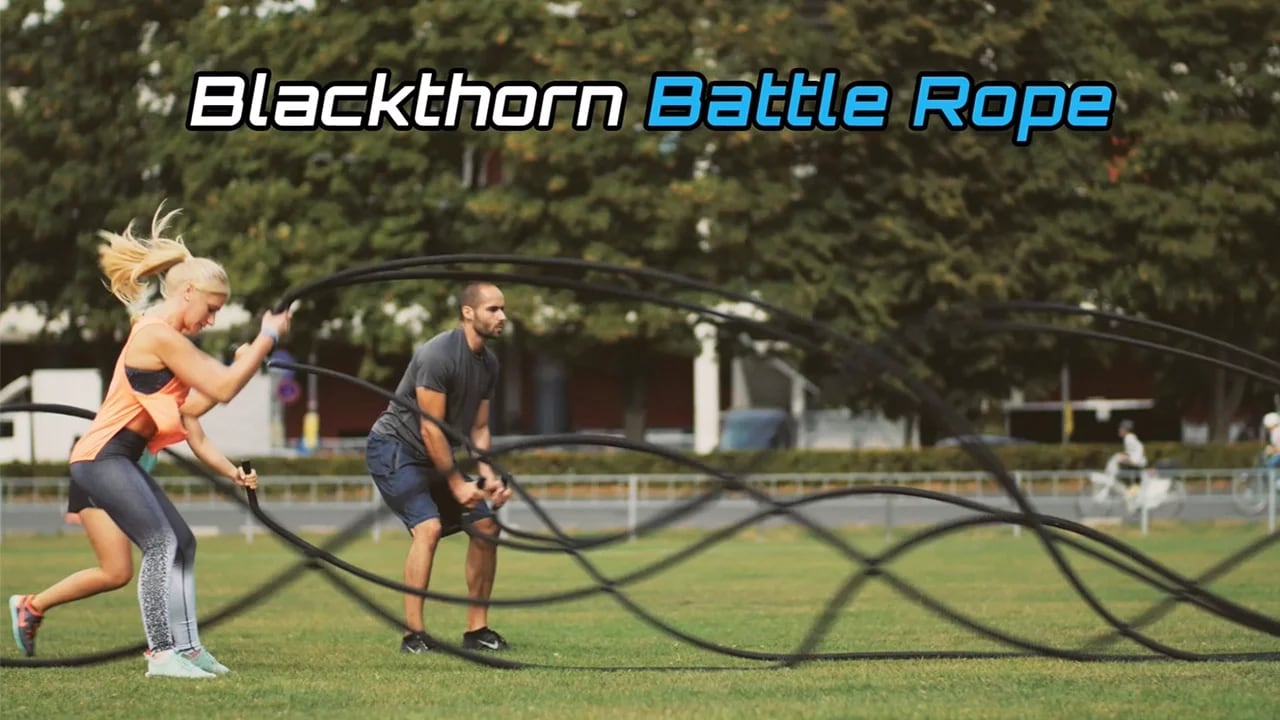
Video
Start making waves
Training with Battle Ropes might look easy but it can be extremely challenging. The ropes are between 10 and 20 m long and the trainee swings them in different ways to create waves that run towards the anchor. This involves your Arms, Shoulders, Core and even your Legs. It´s an effective cardio training that can be a full workout on its own as well as a challenging finisher at the end of a workout.
How does Battle Rope training work?
The Battle Rope is fixed to a central anchor so will need a little more then half the rope length as training space. The athlete holds both ends in his hands. The number of exercises is surprisingly high: apart from the well-known wave patterns (which can be done synchronous or alternating) you can do circles with your arms in front of your body or shake the rope horizontally so that it flows like two snakes towards the anchor point. Or explosively move both ends simultaneously from one side of your body to the other side. If you change your body position during the exercises – e.g. doing lunges at the same time or swinging the rope from a plank position – you can intensify your rope workouts even more.
aerobis for highest quality
Common Battle Ropes are often made of hemp or nylon. These materials, however, are not the best choice for fitness training ropes. They are not flexible enough for optimal waves and not suitable for outdoor training. aerobis Battle Ropes are made of polyester and manufactured with a complex weaving technique. This makes them heavier than other training ropes and, at the same time, more flexible. A stabilizing rope core is sewn up with the outer layer, guaranteeing that the Battle Ropes always keep their form. Additionally, aerobis Battle Ropes are UV-resistant and don’t soak up water. Thus, battle ropes by aerobis are not only suitable for indoor training but can also be used in outdoor trainings.
How much space do I need?
To train with a battle rope, you’ll need roughly half the length of the rope as usable training space. Additionally, leave 2–3 meters (6.5–10 ft) of clearance on each side for unrestricted movement. For example, if your available training area is 6 meters (20 ft) long, a 10-meter (33 ft) battle rope would be a perfect fit.
When choosing a rope, prioritize length over diameter. Use the maximum length that your space allows, as longer ropes provide more versatility and allow you to adjust workout intensity more effectively by varying the wave distance. Longer ropes create smoother, larger waves, making it easier to modify the difficulty level.
What diameter should I choose?
aerobis Battle Ropes come in two diameters: 30 mm (1.2 in) and 40 mm (1.6 in). The diameter directly affects the difficulty of the exercises, as thicker ropes are heavier and require significantly more strength and endurance to generate waves.
- 30 mm (1.2 in): Ideal for beginners and general fitness training. Easier to grip and lighter, making it suitable for longer sessions and high-rep training.
- 40 mm (1.6 in): Recommended for advanced users and athletes seeking a challenge. The increased thickness and weight demand greater strength and effort, making it perfect for building power and grip strength.
Which Battle Rope is right for me?
For beginners, we recommend starting with a 30 mm (1.2 in) diameter rope to focus on technique and endurance. Experienced athletes or those looking for maximum intensity should choose the 40 mm (1.6 in) version for a more demanding workout.
Start making waves
Training with Battle Ropes might look easy but it can be extremely challenging. The ropes are between 10 and 20 m long and the trainee swings them in different ways to create waves that run towards the anchor. This involves your Arms, Shoulders, Core and even your Legs. It´s an effective cardio training that can be a full workout on its own as well as a challenging finisher at the end of a workout.
How does Battle Rope training work?
The Battle Rope is fixed to a central anchor so will need a little more then half the rope length as training space. The athlete holds both ends in his hands. The number of exercises is surprisingly high: apart from the well-known wave patterns (which can be done synchronous or alternating) you can do circles with your arms in front of your body or shake the rope horizontally so that it flows like two snakes towards the anchor point. Or explosively move both ends simultaneously from one side of your body to the other side. If you change your body position during the exercises – e.g. doing lunges at the same time or swinging the rope from a plank position – you can intensify your rope workouts even more.
aerobis for highest quality
Common Battle Ropes are often made of hemp or nylon. These materials, however, are not the best choice for fitness training ropes. They are not flexible enough for optimal waves and not suitable for outdoor training. aerobis Battle Ropes are made of polyester and manufactured with a complex weaving technique. This makes them heavier than other training ropes and, at the same time, more flexible. A stabilizing rope core is sewn up with the outer layer, guaranteeing that the Battle Ropes always keep their form. Additionally, aerobis Battle Ropes are UV-resistant and don’t soak up water. Thus, battle ropes by aerobis are not only suitable for indoor training but can also be used in outdoor trainings.
How much space do I need?
To train with a battle rope, you’ll need roughly half the length of the rope as usable training space. Additionally, leave 2–3 meters (6.5–10 ft) of clearance on each side for unrestricted movement. For example, if your available training area is 6 meters (20 ft) long, a 10-meter (33 ft) battle rope would be a perfect fit.
When choosing a rope, prioritize length over diameter. Use the maximum length that your space allows, as longer ropes provide more versatility and allow you to adjust workout intensity more effectively by varying the wave distance. Longer ropes create smoother, larger waves, making it easier to modify the difficulty level.
What diameter should I choose?
aerobis Battle Ropes come in two diameters: 30 mm (1.2 in) and 40 mm (1.6 in). The diameter directly affects the difficulty of the exercises, as thicker ropes are heavier and require significantly more strength and endurance to generate waves.
- 30 mm (1.2 in): Ideal for beginners and general fitness training. Easier to grip and lighter, making it suitable for longer sessions and high-rep training.
- 40 mm (1.6 in): Recommended for advanced users and athletes seeking a challenge. The increased thickness and weight demand greater strength and effort, making it perfect for building power and grip strength.
Which Battle Rope is right for me?
For beginners, we recommend starting with a 30 mm (1.2 in) diameter rope to focus on technique and endurance. Experienced athletes or those looking for maximum intensity should choose the 40 mm (1.6 in) version for a more demanding workout.
FAQ - frequently asked questions
What are Battle Ropes?
aerobis Battle Ropes - also known as battling ropes, training ropes, or power ropes - are versatile fitness tools that support a wide range of functional exercises. Typically, both ends of the rope are gripped with one hand each. Our battle ropes come in various lengths and diameters to suit different training needs.
What sets aerobis Battle Ropes apart is their exceptional quality and durability. Made with a flexible polyester shell using a complex weaving technique, they maintain their shape and resist wear. The handle ends are securely sewn to the rope core to prevent slipping during intense workouts. Thanks to their superior wave properties, training with aerobis Battle Ropes is more effective and smoother compared to conventional twisted ropes.
How do I maintain a Battle-Rope?
With fiber-based ropes, it’s normal for individual strands to loosen over time. Unlike basic twisted ropes, this isn’t an issue with aerobis Battle Ropes because they won’t unravel. You can easily repair loose strands using a simple lighter to seal the ends. Check out this video for a step-by-step guide on how to repair your aerobis Battle Rope.
What exercises can be done with a Battle Rope?
When most people think of battle ropes, they picture the classic wave motions and basic exercises. However, battle ropes offer far more than that. Our online training showcases the best exercises for getting started with functional rope training. The possibilities are virtually endless—ranging from using the rope’s own weight for resistance to partner drills and complex, full-body movements.
What are the advantages of Battle Ropes?
Battle rope workouts are highly effective for building strength and muscular endurance. The continuous tension during exercises makes the training both intense and efficient. These workouts primarily target the upper body—especially the shoulders and arms—while also engaging the lower body when combined with movements like squats or lunges, resulting in a full-body workout. Additionally, battle rope exercises are an excellent way to improve grip strength, as it is challenged in nearly every movement.
When performed with proper technique, battle rope training is safe and suitable for all fitness levels—from beginners to experienced athletes.
How much space do I need to train with a Battle Rope?
Training with a battle rope requires more space than most other training tools due to its length, typically between 10 and 15 meters (33–50 ft). Although the rope is doubled at the anchor point—reducing the working length in half—you’ll still need enough clearance in front of the anchor.
For a 10-meter (33 ft) rope, you’ll need 5 meters (16.5 ft) from the anchor to the end of the rope. For a 15-meter (50 ft) rope, the required space increases to 7.5 meters (25 ft).
The space required to the sides is minimal. With just 2 meters (6.5 ft) of width, you can perform most exercises without restriction, making battle ropes suitable for various environments, as long as you have enough space in front of the anchor.
Where do I mount Battle Ropes?
A battle rope can be anchored to any sturdy structure that can handle the forces generated during training. Outdoors, suitable options include park benches, trees, or lamp posts. Indoors, you can secure the rope using a heavy object like a kettlebell or dumbbell. For a more permanent and reliable solution, consider using our included Rope Mount.
Can I use a Battle Rope indoors or outdoors?
aerobis Battle Ropes are highly recommended for outdoor use. Made from durable polyester, they offer significant advantages over hemp-based ropes. They won’t stretch, even when exposed to water, and their UV resistance ensures a long lifespan, making them ideal for all-weather training.
